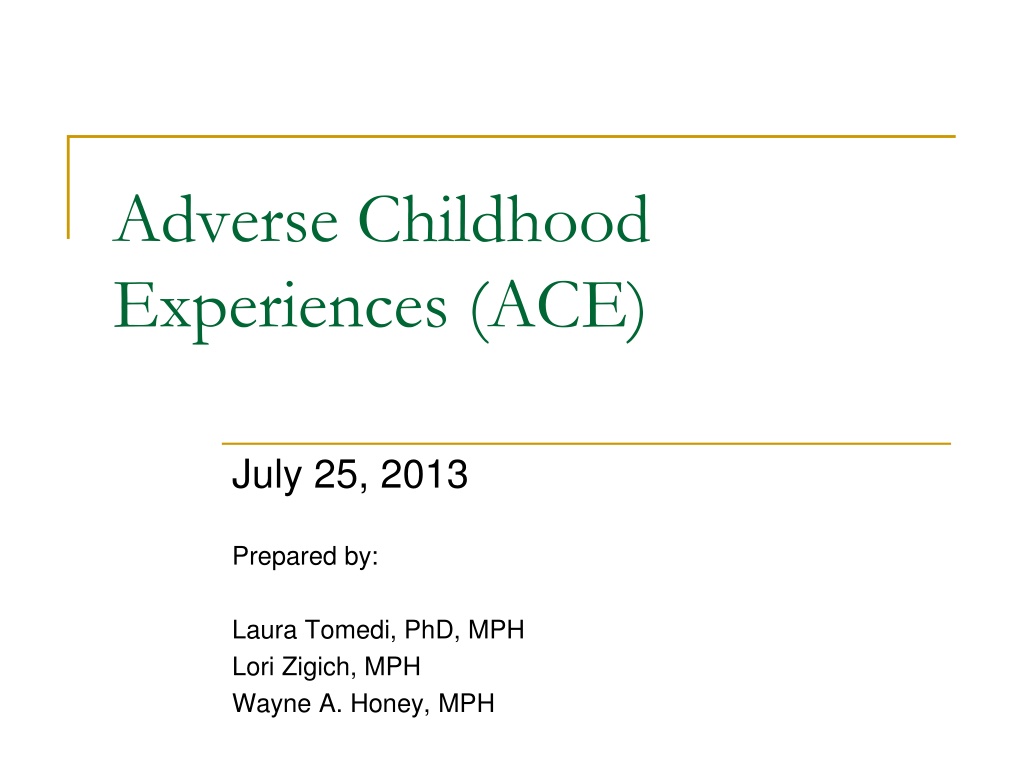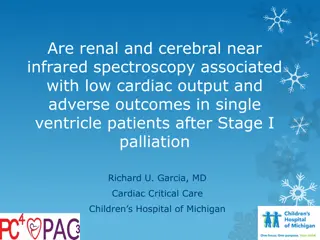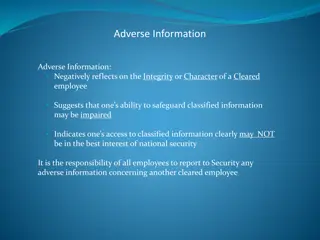Understanding Adverse Childhood Experiences (ACE) Study and Findings
The Adverse Childhood Experiences (ACE) Study conducted by CDC and Kaiser Permanente examines the impact of childhood trauma on health outcomes. It defines and discusses various ACE factors like abuse, neglect, and household dysfunction. The study reveals that such experiences in childhood can significantly increase the risk of physical and mental health issues later in life. These findings emphasize the importance of addressing childhood trauma to improve overall well-being and quality of life.
Download Presentation

Please find below an Image/Link to download the presentation.
The content on the website is provided AS IS for your information and personal use only. It may not be sold, licensed, or shared on other websites without obtaining consent from the author. Download presentation by click this link. If you encounter any issues during the download, it is possible that the publisher has removed the file from their server.
E N D
Presentation Transcript
Adverse Childhood Experiences (ACE) July 25, 2013 Prepared by: Laura Tomedi, PhD, MPH Lori Zigich, MPH Wayne A. Honey, MPH
Adverse Childhood Experiences (ACE) Study Prospective Cohort Study Collaboration between Centers for Disease Control & Prevention and Kaiser Permanente Health Appraisal Clinic 17,000+ HMO members enrolled in study between 1995 and 1997 Initial physical exam and interview On-going tracking of medical status of study participants Adverse Childhood Experiences (ACE) Study, CDC Website: http://www.cdc.gov/ace/index.htm
Conceptual Framework Findings suggest certain childhood experiences are important risk factors for the leading causes of illness and death, as well as poor quality of life. Source: Adverse Childhood Experiences (ACE) Study. Accessed at http://www.cdc.gov/ace/pyramid.htm. Retrieved June 6, 2012.
ACE Defined: The following factors occurring in a person s first 18 years of life. Abuse Emotional - Often or very often a parent or other HH adult: Swore at you Insulted you Put you down Made you feel that you might be physically hurt Physical Sometimes, often, or very often: Pushed, grabbed, slapped, or had something thrown at you or ever hit you so hard that you had marks or were injured. Sexual An adult or person at least 5 years older ever: touched or fondled you in a sexual way, or had you touch their body in a sexual way or attempted oral, anal, or vaginal intercourse with you or actually had oral, anal, or vaginal intercourse with you. Source: Adverse Childhood Experiences (ACE) Study, http://www.cdc.gov/ace/prevalence.htm. Retrieved June 6, 2012.
ACE Defined: The following factors occurring in a person s first 18 years of life. Neglect Emotional - Emotional Neglect Subscale of Childhood Trauma Questionnaire (CTQ), moderate to extreme scores Asked whether family: made them feel special and loved was a source of strength, support, and protection. Physical - Emotional Neglect Subscale of Childhood Trauma Questionnaire (CTQ), moderate to extreme scores Asked whether: Enough to eat Parents drinking interfered with care Ever wore dirty clothes If there was someone to take them to the doctor Source: Adverse Childhood Experiences (ACE) Study, http://www.cdc.gov/ace/prevalence.htm. Retrieved June 6, 2012.
ACE Defined: The following factors occurring in a person s first 18 years of life. Household dysfunction Mother treated violently Sometimes, often, or very often pushed, grabbed, slapped, kicked, bitten, hit with a fist, or hit with something hard or had something thrown at her, or ever repeatedly hit over at least a few minutes or ever threatened or hurt by a knife or gun Household substance abuse Lived with anyone who was a problem drinker or alcoholic or lived with anyone who used street drugs (or abused prescription drugs?) Household mental illness A household member was depressed or mentally ill or attempted suicide Parental separation or divorce Parents were ever separated or divorced Incarcerated household member Source: Adverse Childhood Experiences (ACE) Study, http://www.cdc.gov/ace/prevalence.htm. Retrieved June 6, 2012.
The ACE studyhas demonstrated that as the number of ACE increase, the risk for the following health problems increases in a strong and graded fashion: Risk for Intimate Partner Violence Alcoholism and alcohol abuse Early Initiation of Smoking Current Smoking Illicit Drug Use Multiple Sexual Partners Sexually Transmitted Diseases Early Initiation of Sexual Activity Adolescent Pregnancy Unintended Pregnancies Fetal Death Chronic Obstructive Pulmonary Disease Ischemic Heart Disease Liver Disease Health-related Quality of Life Depression Suicide Attempts Source: Adverse Childhood Experiences Study: Major Findings. http://www.cdc.gov/ace/findings.htm. Retrieved June 6, 2012.
Prevalence & Distribution of ACE Among Adults in NM 2009 Telephone survey of randomly selected adults aged 18 years and older. Adverse Childhood Experiences (ACE) module added to Behavioral Risk Factor Surveillance System (BRFSS) in five states in 2009. Eleven questions yielding eight categories of ACE referring to the time before they were aged 18 years. 5,271 adult New Mexicans completed ACE Module. Source: Adverse Childhood Experiences Report by Adults --- Five States, MMWR, December 17, 2010 / 59(49);1609-1613.
New Mexico 2009 NM BRFSS ACE Questions Introduction: I d like to ask you some questions about events that happened during your childhood. This information will allow us to better understand problems that may occur early in life, and may help others in the future. This is a sensitive topic and some people may feel uncomfortable with these questions. At the end of this section, I will give you a phone number for an organization that can provide information and referral for these issues. Please keep in mind that you can ask me to skip any question you do not want to answer. All questions refer to the time period before you were 18 years of age. Now, looking back before you were 18 years of age--
New Mexico 2009 NM BRFSS ACE Questions Did you live with anyone who was depressed, mentally ill, or suicidal? Did you live with anyone who was a problem drinker or alcoholic? Did you live with anyone who used illegal street drugs or who abused prescription medications? Did you live with anyone who served time or was sentenced to serve time in a prison, jail, or other correctional facility?
New Mexico 2009 NM BRFSS ACE Questions Were your parents separated or divorced? How often did your parents or adults in your home ever slap, hit, kick, punch or beat EACH OTHER up? Never, Once, More Than Once Before age 18, how often did a parent or adult in your home ever hit, beat, kick, or physically hurt YOU in any way? Do not include spanking. Would you say--- Never, Once, More Than Once How often did a parent or adult in your home ever swear at you, insult you, or put you down? Never, Once, More Than Once
New Mexico 2009 NM BRFSS ACE Questions How often did anyone at least 5 years older than you or an adult, ever touch you sexually? Never, Once, More Than Once How often did anyone at least 5 years older than you or an adult, try to make you touch them sexually? Never, Once, More Than Once How often did anyone at least 5 years older than you or an adult, force you to have sex? Never, Once, More Than Once
New Mexico 2009 NM BRFSS Key Limitations Sample Frame limited to non-institutionalized adults living in a private residence with a landline telephone. Self-reported information dependent on recall ability and willingness to report. Also a strength. Only current demographic and SES information no such information for time ACE s occurred. Extremely limited info on person(s) causing harm Association Yes; Causation No
Percent of New Mexico adults aged > 18 years reporting an Adverse Childhood Experience, Five States Study, BRFSS 2009 100% New Mexico* All Five States** 80% 60% 40% 30% 29% 28% 27% 26% 24% 20% 19% 19% 19% 16% 15% 13% 20% 12% 7% 7% 0% *n=5,271 (randomly selected New Mexico residents). **n=26,229 (includes randomly selected residents from Arkansas, Louisiana, New Mexico, Tennessee, and Washington). Source of data: Adverse Childhood Experiences Report by Adults --- Five States, MMWR, December 17, 2010 / 59(49);1609-1613.
Results of 2009 NM BRFSS: Percent of New Mexico adults* aged >18 years reporting zero through 5 or more adverse childhood experiences. 16.7% 9.6% 7.1% 0 ACEs 1 ACEs 2 ACEs 3 ACEs 4 ACEs 5 ACEs 38.9% 10.0% 12.6% 21.8% *n=5,271 Source of data: Adverse Childhood Experiences Report by Adults --- Five States, MMWR, December 17, 2010 / 59(49);1609-1613.
Percent of New Mexico Adult ACEs, by Age Group (Significant) Four+ ACE's Three ACE's Two ACE's One ACE Zero ACE 75+ 65 - 74 55 - 64 45 - 54 35 - 44 25 - 34 18 - 24 0 10 20 30 40 50 60 70 Source of data: Wayne A. Honey, MPH, Behavioral Risk Factor Surveillance System, 2009. New Mexico Department of Health. Prepared July 25, 2013.
Percent of New Mexico Adult ACEs, by Gender (Significant) Four+ ACE's Three ACE's Two ACE's One ACE Zero ACE Female Male 0 10 20 30 40 50 60 70 Source of data: Wayne A. Honey, MPH, Behavioral Risk Factor Surveillance System, 2009. New Mexico Department of Health. Prepared July 25, 2013.
Percent of New Mexico Adult ACEs, by Sexual Orientation (Significant) Four+ ACE's Three ACE's Two ACE's One ACE Zero ACE Heterosexual LGBT 0 10 20 30 40 50 60 70 Source of data: Wayne A. Honey, MPH, Behavioral Risk Factor Surveillance System, 2009. New Mexico Department of Health. Prepared July 25, 2013.
Percent of New Mexico Adult ACEs, by Race/Ethnicity (Not Significant) Four+ ACE's Three ACE's Two ACE's One ACE Zero ACE AIAN AsianNHOPI BlackAA Hispanic White 0 10 20 30 40 50 60 70 Source of data: Wayne A. Honey, MPH, Behavioral Risk Factor Surveillance System, 2009. New Mexico Department of Health. Prepared July 25, 2013.
Percent of New Mexico Adult ACEs, by Region of Residence (Not Significant) Four+ ACE's Three ACE's Two ACE's One ACE Zero ACE Southwest Southeast Bernalillo Co. Northeast Northwest 0 10 20 30 40 50 60 70 Source of data: Wayne A. Honey, MPH, Behavioral Risk Factor Surveillance System, 2009. New Mexico Department of Health. Prepared July 25, 2013.
Percent of New Mexico Adult Demographics by Number of Adverse Childhood Experiences Four+ ACE's Three ACE's Two ACE's One ACE Zero ACE College Grad. $50,000+ Unable to Work No Health Coverage 0 10 20 30 40 50 60 70 Source of data: Wayne A. Honey, MPH, Behavioral Risk Factor Surveillance System, 2009. New Mexico Department of Health. Prepared July 25, 2013.
Health Behaviors by Number of Adverse Childhood Experiences Four+ ACE's Three ACE's Two ACE's One ACE Zero ACE No Exercise Binge Drinking Current Smoker 0 10 20 30 40 50 60 70 Source of data: Wayne A. Honey, MPH, Behavioral Risk Factor Surveillance System, 2009. New Mexico Department of Health. Prepared July 25, 2013.
Health Conditions and Disease by Number of Adverse Childhood Experiences Four+ ACE's Three ACE's Two ACE's One ACE Zero ACE Current Asthma Fall w/Injury Hypertension 0 10 20 30 40 50 60 70 Source of data: Wayne A. Honey, MPH, Behavioral Risk Factor Surveillance System, 2009. New Mexico Department of Health. Prepared July 25, 2013.
Health Conditions and Disease by Number of Adverse Childhood Experiences Four+ ACE's Three ACE's Two ACE's One ACE Zero ACE High Cholesterol Disability CVD Diabetes 0 10 20 30 40 50 60 70 Source of data: Wayne A. Honey, MPH, Behavioral Risk Factor Surveillance System, 2009. New Mexico Department of Health. Prepared July 25, 2013.
General Health Status by Number of Adverse Childhood Experiences Mean Days of Poor Sleep by Number of ACE s None: One: Two: Three: Four+: 5.9 6.9 8.9 9.3 10.9 (9.9, 12.0) (5.2, 6.6) (6.0, 7.7) (7.7, 10.0) (7.9, 10.7) Source of data: Wayne A. Honey, MPH, Behavioral Risk Factor Surveillance System, 2009. New Mexico Department of Health. Prepared July 25, 2013.
General Health Status by Number of Adverse Childhood Experiences Mean Days of Poor Physical or Mental Health Prevented Usual Activities, by Number of ACE s None: One: Two: Three: Four+: 1.5 1.7 2.0 2.5 3.9 (1.2, 1.7) (1.3, 2.1) (1.4, 2.6) (1.8, 3.3) (3.2, 4.6) Source of data: Wayne A. Honey, MPH, Behavioral Risk Factor Surveillance System, 2009. New Mexico Department of Health. Prepared July 25, 2013.
Health Disparities New Mexico residents with >4 ACEs were more likely to be: Female (19.3%) than male (13.4%) Black (23.9%) and American Indian (22.7%) than white (14.1%) Younger - 18 to 44 years old (20.7%) than 75+ years old (2.9%) Source: Laura Tomedi, MPH, PhD, New Mexico Behavioral Risk Factor Surveillance System, 2009. New Mexico Department of Health. Prepared June 7, 2012.
Selected Health Outcomes Compared to persons with 0 ACEs, New Mexico residents with >4 ACEs were more likely to report: Fair/Poor Health (21.6% vs. 15.4%) Smoking (33.6% vs. 12.6%) Injury due to falls (50.3% vs. 26.6%) But were less likely to report hypertension (23.1% vs. 28.1%) Source of data: Laura Tomedi, MPH, PhD, New Mexico Behavioral Risk Factor Surveillance System, 2009. New Mexico Department of Health. Prepared June 7, 2012.
Conclusion New Mexico adults with 4+ ACE s are more likely to have poor mental health, to have asthma, to binge drink, to heavily drink, and are less likely to have health insurance then adults with 0 ACE. Conversely, there is no difference in diabetes, arthritis, high cholesterol, obesity, or physical activity between the two groups. Source of data: Laura Tomedi, MPH, PhD, New Mexico Behavioral Risk Factor Surveillance System, 2009. New Mexico Department of Health. Prepared June 7, 2012.
Conclusion The high prevalence of ACEs underscores the need for: 1. additional efforts at the state and local level to reduce and prevent child maltreatment and associated family dysfunction; and 2. further development and dissemination of trauma-focused services to treat stress- related health outcomes associated with ACEs. Source: Adverse Childhood Experiences Report by Adults --- Five States, MMWR, December 17, 2010 / 59(49);1609- 1613.























